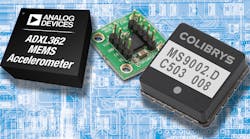Accelerometers—devices that measure change in velocity—are built into automobiles, airplanes, cell phones, pacemakers, and scores of other products. They warn of potentially destructive vibrations in industrial equipment, buildings, and bridges; register seismic shocks; and guide missiles to their targets.
Increasingly, they are miniaturized using microelectromechanical systems (MEMS) technologies with component dimensions on the order of micrometers, and simultaneously register acceleration in all three axes of three-dimensional space. Errors are additive when calculating velocity from acceleration, so even minor errors in output can have very serious consequences.
Yet when three-axis sensitivities and cross-axis sensitivities of a digital three-axis device are tested at different calibration laboratories, the measurements can vary substantially depending on factors that can be difficult to determine, but often arise from errors with alignment of the test equipment, the internal alignment of the accelerometers in the device, or both.
Now NIST scientists have devised a method that reduces or eliminates those differences by characterizing an accelerometer’s intrinsic properties—those unique to it irrespective of the way it is mounted or tested—thus making possible accurate interlaboratory comparisons.
“Determining the intrinsic properties is part of NIST’s larger effort to help industry develop standard testing protocols for the new MEMS-based device technologies, which do currently not exist,” says Michael Gaitan of NIST’s Physical Measurement Laboratory, which is working with the MEMS and Sensors Industry Group (MSIG) and the Institute of Electrical and Electronics Engineers. “Testing was reported by MSIG to be as much as half the cost of manufacturing for these sorts of devices. Manufacturers can’t reduce the cost of physical fabrication very much. But they can find savings in the way they package, test, and calibrate them.”
When MEMS-based, three-axis accelerometers are tested, they are typically mounted on a gimbal system and rotated about three axes—x, y, and z—with measurements taken in different orientations. The measurements are formatted in a three-by-three grid, called a “cross-sensitivity matrix,” used by manufacturers to evaluate device performance. It specifies the relation between the acceleration responses along the gimbal axes to the response along the axes of the device being tested.
That process, however, assumes the MEMS accelerometer’s three axes are orthogonal—at right angles to each other—and the device has been mounted in perfect alignment with the gimbal axes, which are themselves perfectly aligned. And when testing accelerometer packages after they have been in products, such as smartphones, it assumes the package was installed in exact alignment with the axes of the phone case. But none of those conditions is guaranteed, and slight deviations in any of the variables can explain why measurements of the same test unit made at different labs generate different values.
“So instead of using the cross-sensitivity matrix alone,” Gaitan says, “we’re defining the MEMs device as having intrinsic properties in which the axes of the device are not assumed to be completely orthogonal. There might be some alignment variations.”
In NIST’s measurement protocol, the device is mounted on the position and rate table, which accurately rotates the device in specific gradations through 360 deg. on each of the gimbal’s three axes while measuring the device’s response at each interval. The protocol reveals the accelerometer’s internal axis alignment, the magnitude of response of each axis in different orientations, and its “signal offset”—the constant amount by which measured readings differ from the “true” value.
With that information, a central standards laboratory such as NIST could fully characterize the intrinsic properties of one or more accelerometers and distribute them to other labs, which would use them as standards to compare results and determine, for example, whether readings were skewed because of instrument-related measurement errors.
Earlier this year, NIST acquired a new position and rate table large enough to permit measurements on entire products that have accelerometers installed. “Our initial gimbal system was a smaller instrument that was useful for making static measurements,” Gaitan says.
“But now we can make dynamic measurements on objects as large as a cell phone. We can set it to steady-state rotation like a record player, and we can accelerate the rotation rate. That will let us make measurements above the 1g acceleration of gravity and measure acceleration by rotation.”
